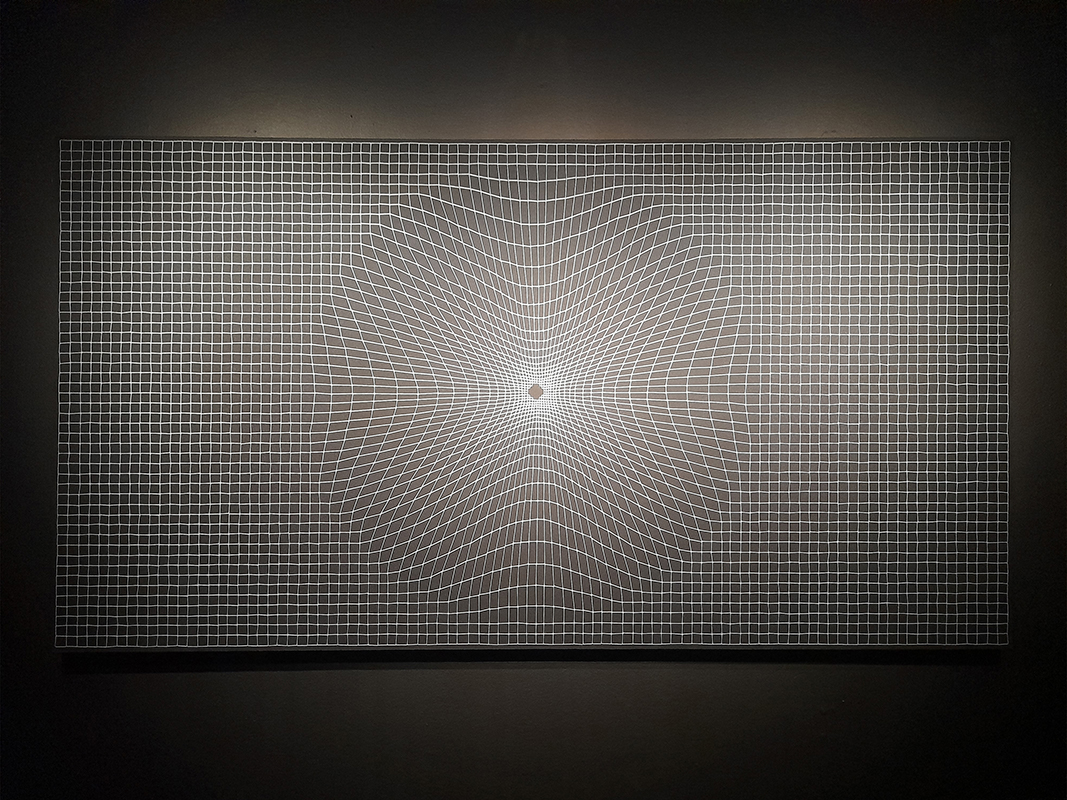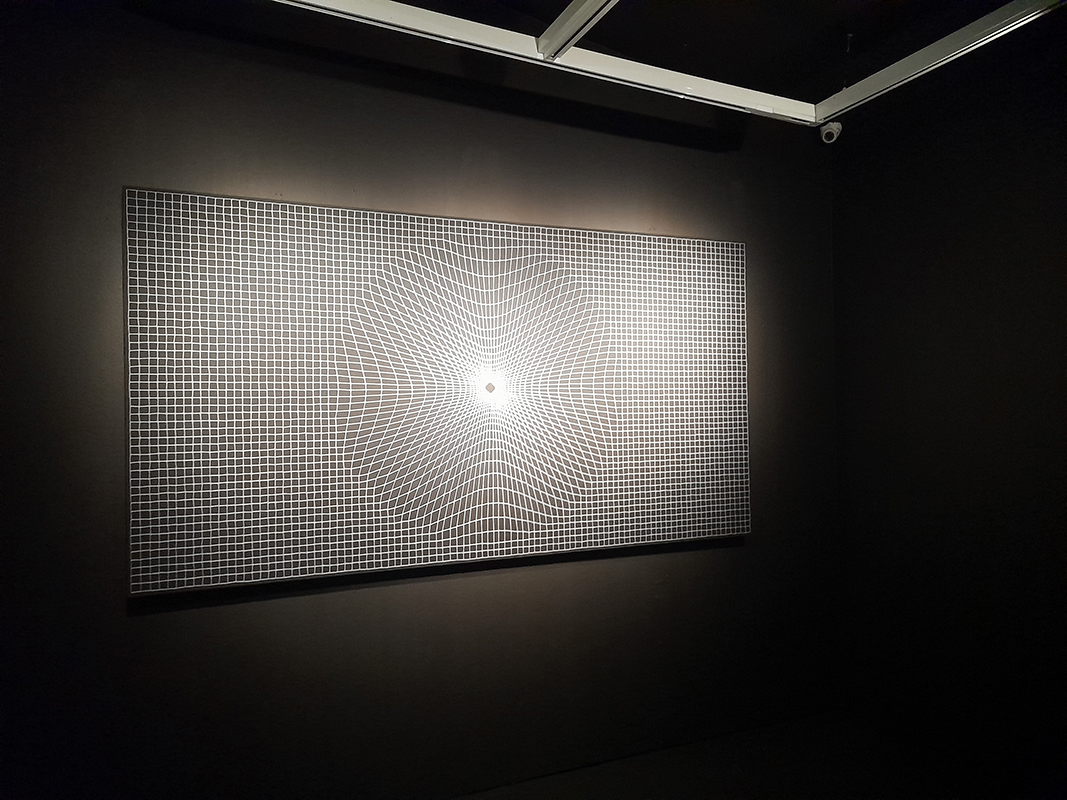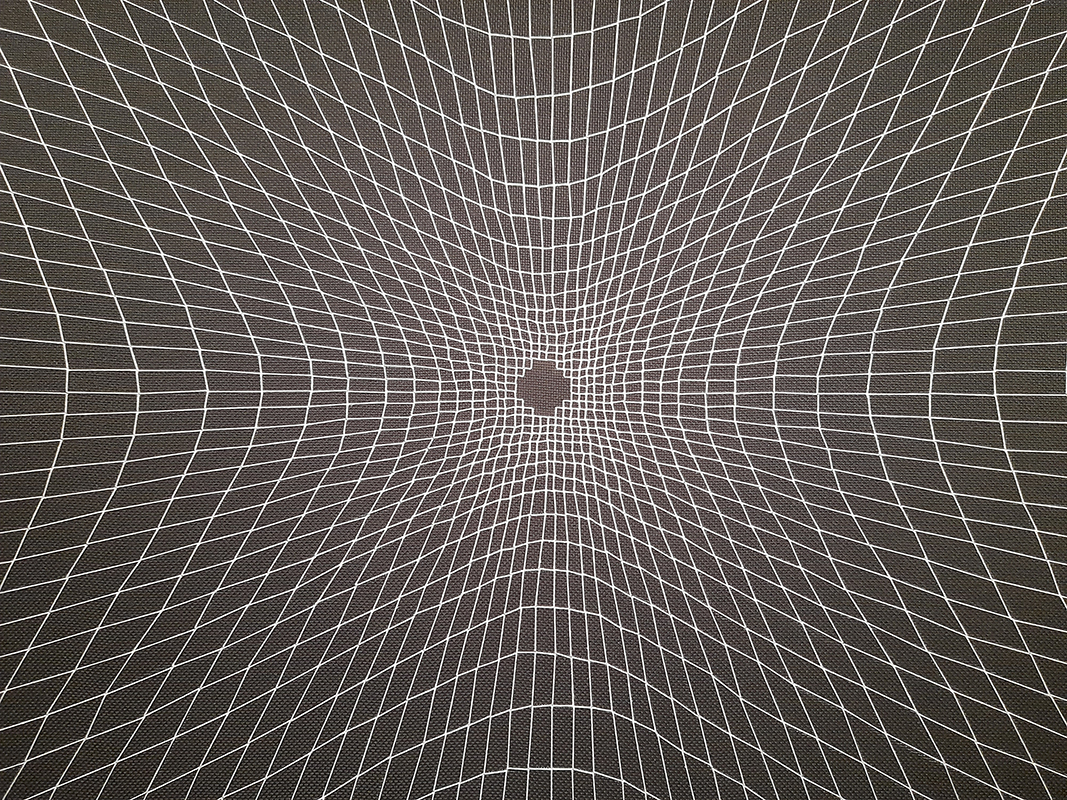One might look at Celine Lee’s works and feel intimidated by their scope. As an artist, her practice treads the line between artmaking and scientific exploration. She often employs heavily technical processes, resulting in works that challenge notions of contemporary expression. Her works constantly evolve, changing form, medium, and concept, reflecting a body of works as prolific as it is inquisitive. Thus, perhaps one might also see in such a practice a kind of projection – one that takes all these complex inner workings and projects outward an earnest search for knowledge and ways to convey human perception.
“Passing” marks Celine Lee’s fifth solo exhibition. In this show, she presents a single piece, measuring 50 x 94.5 inches, in a viewing space painted entirely black. Across a canvas of black Aida cloth, Lee embroidered a simple grid pattern using white thread. At the very center of the work, a palpable gravitational force pulls the threads in toward an unseen mass. The threads warp and converge around this very conspicuous focal point, effectively creating what appears to be an endless void in space from the barest of two-dimensional maneuvering. While the work from afar may appear to be some kind of optical trip, it has as magnetic an effect on viewers as it does on each thread, pulling them into the very same mysterious center.
This manner of embroidery is one of the many material explorations Lee has undertaken as an artist working with such abstract ideas. Her work in ‘Passing’ is a continuation of a series on Aida cloth started in 2017. Her previous solo show, ‘Artificial,’ presented by Mono8 Gallery last May, featured white embroidery on white canvas that reproduced surfaces generated by 3D software. She stretched the bounds of her material scope in ‘The Length and Breadth of Depth,’ held at Underground Gallery, which was shortlisted for the 2021 Ateneo Art Awards in the Visual Arts category. Here, she brought together paintings, 3D-printed surfaces, and cyberspace to question the experience of the physical at a time when daily life is conducted virtually. Her work further earned her an award of merit at the 2020 Philippine Art Awards.
Scientific ideas play a major role in Lee’s art. And however simple “Passing” may initially seem, several dense theories underscore it. An immediate glance at the work sends the viewer down the rabbit hole of general relativity. The theory of general relativity suggests the existence of four-dimensional spacetime, where a body not only warps the three dimensions of space, but time as well. In Lee’s work, a centripetal pull alters the uniformity of the surrounding grid. The materiality of the thread lends itself to this phenomenon known as time dilation, where time stretches approaching the center of a gravitational pull. The threads weave through each methodical grid until they begin to stretch and shrink. At the same time, one can imagine the way time speeds up and slows down in relation to the artist’s embroidering of each individual unit. All of this, in practice and theory, alluding to the ultimate relative nature of time.
Another concept that is seemingly suggested in the work is the Doppler effect. This is the compression or lengthening of waves in relation to a fixed point. This effect creates the sudden shift in pitch of a horn or siren as a vehicle approaches and whizzes past an observer. It also results in the differences in colors of stars as they move relative to the Earth at different speeds. In the scientific mind, a connection may be found between the Doppler effect and the way Lee’s work appears to change depending on the viewer’s point of view. Whether viewed from the side, below, or at any oblique angle, the visual path traced from one’s eye to the center changes and the topography of the work shifts. Perspective adds additional layers of experience to the otherwise straightforward visuals of the piece.
All said, Lee’s work is an artwork, after all. Reading her piece for “Passing” on only a surface, scientific level would do a disservice to the depth of ideas on display. In the write-up for the show, a personal connection is made to the artist’s anxieties. The focus on the central point and the way all the threads and all their implications of time and space travel toward it is enough to stir up optical and maybe even existential anxieties. One does not know where this mysterious focal point leads to, nor why it exerts such a strong force upon its surroundings. If anxieties had weight, how heavily would they pull across the hypothetical fabric of spacetime?
Implied in Celine Lee’s embroidery is a reseizing of autonomy. It is easy to get lost while operating on such a broad, cosmic scale. Such simple interventions by the artist’s hand presents a tangible way to confront such notions and anxieties, wherever they exist across time and space. In the repetitive weaving in and out of each thread, the artist may even find peace in the control it offers, all while working within such an uncontrollable and intangible space. And as such, perhaps the unknowable focal point looming ahead may instead be perceived as an end goal, offering clarity within the enigmatic web of time.
Celine Lee’s “Passing” runs until December 2 at Artinformal Makati.
Mara Fabella is an artist, writer, and occasional fitness junkie. Tap the button below to buy her a coffee.



